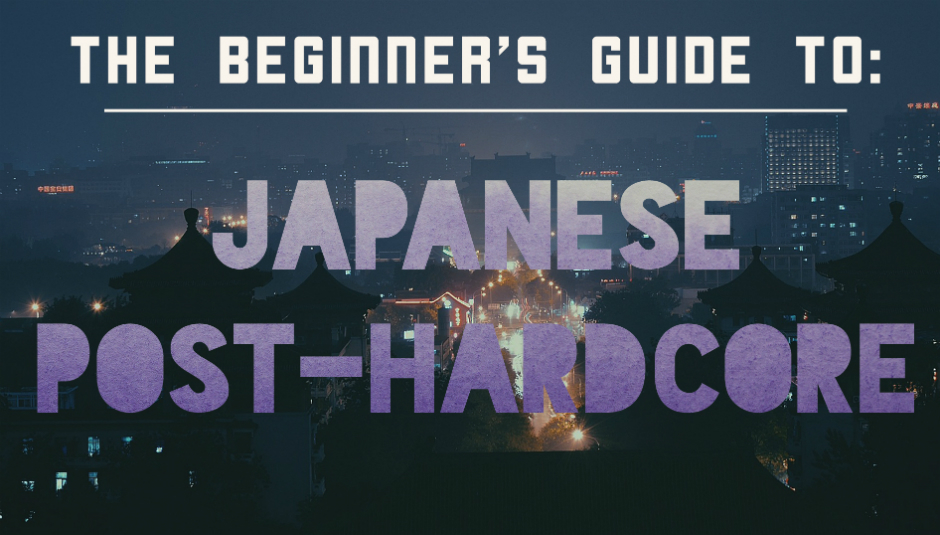Post-Hardcore, the red-headed stepchild of hardcore, was once the only space keeping aggressive indie-rock alive. Underneath the populist takeover of grunge and post-grunge throughout the 90’s groups like At The Drive In, Refused, and Unwound kept the flame alive until post-punk and garage-rock revival could pick up the weight in the early noughts. In recent years though, it’s felt as if the genre has had a very muted influence on the world of indie music. Don’t get me wrong, it’s a genre worth loving, certainly more than the bro-centric “riffage” of its brother genre, but there just isn’t too much Unwound or Dismemberment Plan influence on the indie rock of 2018. While the genre saw a nice ping of resurgence with bands like Joyce Manor and La Dispute circa 2011, post-punk has remained as the primary source material for indie-rock’s core stable of punk-music.
In Japan, however, a dominant thread of true indie-rock music hadn’t even really emerged until the mid-90s. Bands like Blankey Jet City, Sunny Day Service, and eventually Number Girl were Japan’s first experience with a defined indie-rock landscape. The country had lacked the college radio/pirate radio platform which had kept post-punk, jangle pop, and alternative rock alive in the UK and US throughout the previous decade. Which is not to say that they didn’t have any music in those genres, just that the country’s independent “scene” had leaned more heavily into other spaces.
So the book of post-punk vs post-hardcore was yet to be written, and by the early 90s, as bands like Husker Du, Fugazi, and Big Black began to filter in from the west, the sound of post-hardcore became a significant undercurrent for this new indie-rock arena. By the time of Number Girl’s second album, released on a major label in 1999, it was a major thread. A lasting influence which continues to pop up in various ways throughout Japan’s indie-rock lineage. From the direct sonic influence on Tricot, a flag-bearer of the girl-group movement which has defined the 2010s, to the post-hardcore edges of groups like Kinoko Teikoku (who even named a song after Number Girl) that defined the countries late 2000s shoegaze revival.
Japanese indie lives in the shadow of its deep flirtations with post-hardcore, and to know it’s history is to know the history of Japanese indie-rock.
The Golden Age (1990-1999)
bloodthirsty butchers - Kocorono
Number Girl - School Girl Bye Bye
Arguably the first Post-Hardcore band of any import in Japan, bloodthirsty butchers had technically been around since the late 80’s, serving up a brittle and toothy brand of Fugazi worship. The band had achieved some small measure of success and acclaim in that lane with a series of three albums from 1990-1994, but it wasn’t until Kocorono in 1996 however that the band managed to make something in step with modern Japanese sensibilities and the more maudlin indie-rock sound it’s underground had favoured. Fusing elements of noise rock, shoegaze, and straightforward alternative rock with a chaotic style of post-hardcore bloodthirsty butchers would become the blueprint for Japanese post-hardcore for almost a decade after. Crafting something well beyond fetishism or recreation.
The album followed a calendar cycle from '2月 (February)' to '12月 (December)' and then back to '1月 (January)', playing out like a year of your mid-20s, all anguish and sighs covered up by yelps and pleading noise. Its sonics were reflective of a growing cultural inability to escape responsibility and a pointless life-long march drawn-up for a new generation of kids who were secretly yearning for individuation. The album’s new world would eventually culminate with another band’s success as Number Girl’s debut album School Girl Bye Bye would arrive just one year later. Which is not phrased as an insult to either group, but as a massive compliment to the often overlooked bloodthirsty butchers. Heralding what is in many people’s eyes THE Japanese indie rock band. School Girl Bye Bye’s lead single 'Omoide In My Head (which translates as 'Memories In My Head') would become the unofficial anthem of Japanese indie rock and cement the group, especially lead singer Shutoku Mukai as the face of a new generation. When their next album, School Girl Distortional Addict, released two years later on the major label Toshiba EMI they were the undisputed pinnacle of rock aesthetics in Japan. A height they could only reach in the wake of bloodthirsty butchers successes.
The Shift (2000)
Number Girl - Sappukei
Often perceived as a lesser album in the wake of School Girl Bye Bye and its major label follow-up School Girl Distortional Addict, which were, and let’s avoid any exaggeration here, tectonic plate shifting events for the Japanese independent music scene, Sappukei was a subtler tilt. A move towards less populist ends and more obscure sounds. It’s predictions for the new century were violent and nihilistic, restless and filled to the brim with despair. The drum fills were harder, and the nostalgic guitar leads which had defined 90s post-hardcore were now morose and brittle. Trading the nostalgia and melancholy of post-adolescence for the crushing sense of meaningless and despair that follows.
This shift, though it shied away from directly codifying it, would be the launching point from where the Japanese underground could engage in screamo and blackened post-hardcore. A pursuit which would become an underground-wide mad dash after the explosion of Envy’s sophomore album just one year later. Sappukei was a brutalist turn that pushed away transient fans of Number Girl’s blissful antics and hooks throughout the late 90s, drying up any real popular market demand for the softer, more indie-rock leaning brand of post-hardcore. Though groups like Eastern Youth, and bloodthirsty butchers would continue to release underground works in that older style to great acclaim. The extremists were beginning to play for just their insular corners again, and popular indie rock was shifting towards straightforward alternative rock.
The Reaction (2001-2009)
Envy - All The Footprints You’ve Ever Left...
Zazen Boys - Zazen Boys
To call Envy’s sophomore album a hit would be akin to calling a baseball bat through your skull a bang or a bruise. Envy levelled the playing field to ash. All The Footprints You’ve Ever Left And The Fear Expecting Ahead is a cataclysm, an almost completely unheralded reduction of screamo into its base components. A feat of musical genius only surpassed by the band’s talent for rebuilding those pieces into immense post-rock monuments, like Portraits Of Past played by Mogwai, or Godspeed You! Black Emperor on an angsty bender. To this day, almost twenty years later, an entire subgenre of post-rock influenced screamo exists in Envy’s wake, as groups like Heaven in Her Arms continue to toy with the ideas core elements, incorporating blackgaze and post-metal in ways that still sound plausible to what Envy themselves would have done.
Envy of course, by virtue of sounding like a black metal band on a time crunch, had exceedingly low crossover potential. The band’s entire existence served as a reaction to the pop sensibilities that had dominated post-hardcore in the years before Envy’s arrival. It’s ensuing empire was more cult than generation-defining by design, rejecting the work of bands like Number Girl or Eastern Youth and their popular songwriting styles and sentimental tonality. Post-hardcore would never again recover its status as the genre of choice for independent bands under Number Girl’s reign, but it would eventually return to the limelight and popular zeitgeist after a six-or-so year interim. An interim wherein groups like Envy could flourish, pummeling the genre to dust, and where Number Girl’s lead singer Shutoku could finally escape his nightmare of popular success and could continue his work abstracting the genre into its most foreign forms with his new group Zazen Boys.
The Return (2010- )
Ling Tosite Sigure - Still A Sigure Virgin?
It is important to note that Ling Tosite Sigure’s fourth album, Still A Sigure Virgin?, reached number one on the Japanese Billboard charts the week of its release (in Japan their chart is actually called the Oricon charts). Though their third album had reached an incredibly impressive number four on that same chart a year earlier, it was at this moment, in late 2010, that post-hardcore became popularly viable once again. The world of bands like Envy, Zazen Boys, and Kulara was sent back to the shadows, and post-hardcore was again liberated for the people.
Working within the in-vogue styles and aesthetics of Japanese rock music at the time, Ling Tosite Sigure managed to bridge the gap between the dramatic world of J-rock in the late 2000s and the newer trend of math rock which was capturing the Japanese underground by storm. A trend that had been bubbling to the surface ever since the emergence of groups like downy, Zazen Boys, and toe. Ling Tosite Sigure did this all while still operating under the label and umbrella of a post-hardcore band. Their sound remained appealing to purists with a level of virtuoso playing and sonic experimentation that underpinned their songs, but attracted that populist market again through bright mixes and catchy pop melodies. The male to female vocal dynamics which were central to the band’s songwriting gave it a lightness and anime-esque dramatic sheen that could offset the often brutal and complex sonic experiments of the music itself.
And from there the floodgates just kept opening, Mass of the Fermenting Dregs' delightful and dreamy debut album would arrive that same year (technically a month before Still A Sigure Virgin?), and in just short three years Tricot's complete pop-ification of the genre would arrive in the form of their debut album T H E. Post-hardcore had been completely cycled through Japan’s music industry, from indie mainstay to populist platform and then back again, and had become the schema sound of indie-rock for the country. Evoked in the mind at the mention of its name, just as Pixies and Interpol would be for an American. Fuck your Pavements and your Arcade Fires, Japan wanted you to sound like this:























